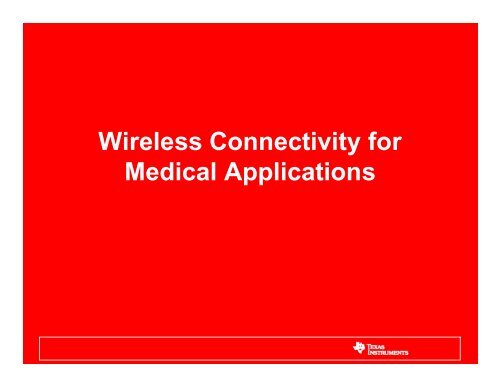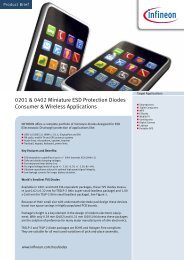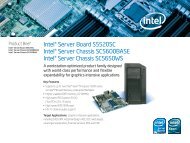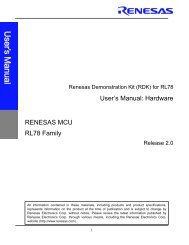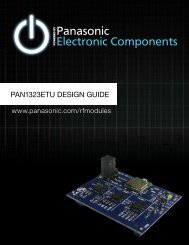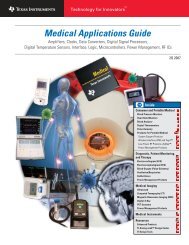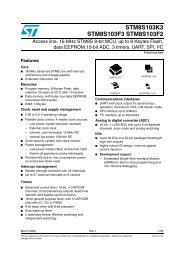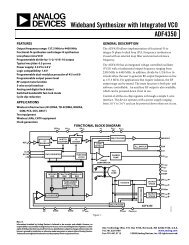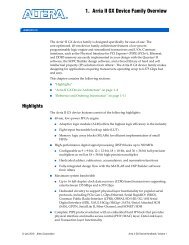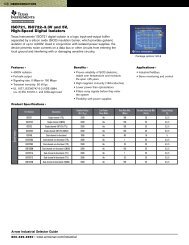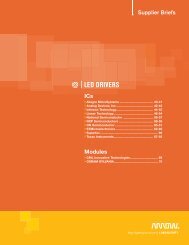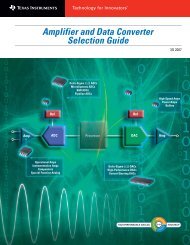Wireless Connectivity for Medical Applications - Arrow Electronics
Wireless Connectivity for Medical Applications - Arrow Electronics
Wireless Connectivity for Medical Applications - Arrow Electronics
You also want an ePaper? Increase the reach of your titles
YUMPU automatically turns print PDFs into web optimized ePapers that Google loves.
<strong>Wireless</strong> <strong>Connectivity</strong> <strong>for</strong><br />
<strong>Medical</strong> <strong>Applications</strong>
<strong>Wireless</strong> <strong>Connectivity</strong> in Healthcare<br />
• <strong>Applications</strong> of <strong>Wireless</strong> <strong>Connectivity</strong> in Medicine<br />
– Remote monitoring of patients with implantable devices<br />
– Chronic disease management<br />
– Wellness and preventive medicine<br />
– Telemedicine<br />
• <strong>Wireless</strong> connectivity enables:<br />
– New ways to collect more data, more frequently, and cheaper<br />
– New ways to connect patients and health care professionals<br />
– New ways to manage health, disease, and life-style<br />
medicalsolutions@arrow.com<br />
2
Data Rate<br />
480 Mbps<br />
300 Mbps<br />
54 Mbps<br />
11 Mbps<br />
3 Mbps<br />
250 kbps<br />
20 kbps<br />
Passive RFID<br />
Potential <strong>Wireless</strong> Standards<br />
For <strong>Medical</strong> <strong>Applications</strong><br />
UWB<br />
IEEE 802.11n<br />
Bluetooth<br />
ULP<br />
Bluetooth<br />
IEEE 802.11a/g<br />
Active RFID<br />
IEEE 802.11b<br />
Zigbee<br />
1 10 100<br />
Range (meters)<br />
medicalsolutions@arrow.com<br />
• Passive RFID<br />
• Active RFID<br />
• Zigbee<br />
• Bluetooth Low Energy<br />
• Bluetooth<br />
• IEEE 802.11b<br />
• IEEE 802.11a<br />
• IEEE 802.11g<br />
• IEEE 802.11n<br />
•UWB<br />
..also GSM/GPRS<br />
3
Comparing <strong>Wireless</strong> Technologies<br />
• Key metrics:<br />
– Data rate<br />
– Range<br />
– Average and peak power consumption, battery life<br />
– Operating spectrum<br />
– Target packet error rate (PER) or bit error rate (BER)<br />
– Interference tolerance (co-existence)<br />
– Time to join the network<br />
– Network topology<br />
– Number of nodes that can be supported within topology<br />
– Memory requirements<br />
– Chip cost => and cost to use<br />
– Deployment volume and timing<br />
medicalsolutions@arrow.com<br />
4
Requirements of the <strong>Applications</strong><br />
• <strong>Applications</strong>:<br />
– Chronic disease management<br />
– Vital signs monitoring<br />
– Health & wellness<br />
– Connected diagnostic devices<br />
Biological Signal Data Rate (kbps)<br />
Blood pressure 0.01 - 10<br />
Pulse / Heart Rate 0.01-10 (40-200 Hz sample)<br />
Temperature 0.01- 10<br />
Respiration 0.01 -10 (10-80 Hz sample)<br />
Glucose 0.01 - 10<br />
SpO2 0.01 – 10<br />
EEG 10 - 200 (500Hz sample, 12-bit ADC, up to 32 channels)<br />
ECG 10 - 200 (500Hz sample, 12-bit ADC, up to 24 channels)<br />
EMG 10 - 500 (500Hz sample, 16-bit ADC, up to 32 channels)<br />
Still Images 1,000 - 2,000<br />
medicalsolutions@arrow.com<br />
5
Unlicensed and Dedicated <strong>Medical</strong> Spectrum<br />
174-216 MHz<br />
470-608 MHz<br />
614-668 MHz<br />
608-614 MHz<br />
1395-1400 MHz<br />
1427-1432 MHz<br />
402-405 MHz<br />
433.05-434.79 MHz<br />
868-870 MHz<br />
902-928 MHz<br />
2400-2483.5 MHz<br />
4940-4990 MHz<br />
5150-5350 MHz<br />
5470-5825 MHz<br />
Frequencies<br />
Available Bandwidth<br />
42 MHz<br />
138 MHz<br />
54 MHz<br />
6 MHz (1.5MHz/chan)<br />
5 MHz<br />
5 MHz<br />
3MHz<br />
1.74 MHz<br />
2 MHz<br />
26 MHz<br />
83.5 MHz<br />
50 MHz<br />
200 MHz<br />
355 MHz<br />
medicalsolutions@arrow.com<br />
<strong>Wireless</strong> medical telemetry at healthcare<br />
facilities – at risk <strong>for</strong> high levels of interference<br />
from DTV signals<br />
WMTS bands<br />
<strong>Medical</strong> Implant Communication Service (MICS)<br />
bands<br />
Europe unlicensed ISM3<br />
Europe unlicensed ISM<br />
US unlicensed ISM<br />
Unlicensed ISM<br />
Public Safety in US<br />
ISM unlicensed<br />
ISM unlicensed<br />
Description<br />
Note: Transmission power varies by country and frequency band. Access rules need to be followed<br />
6
Unlicensed and Dedicated <strong>Medical</strong> Spectrum<br />
202.65-205.15 MHz<br />
Frequencies<br />
420.05-430, 440-449.6625 MHz<br />
420.0625-430, 440-449.6375 MHz<br />
420.075-430, 440-449.6 MHz<br />
420.1-430, 440-449.525 MHz<br />
420.3-430, 440-449.425 MHz<br />
2.5 MHz<br />
Available Bandwidth<br />
Type A: 8.5 KHz<br />
Type B: 8.5kHz < BW < 16kHz<br />
Type C: 16kHz < BW < 32kHz<br />
Type D: 32kHz < BW < 64kHz<br />
Type E: 64kHz < BW < 320kHz<br />
medicalsolutions@arrow.com<br />
Description<br />
WMTS in New Zealand<br />
WMTS bands in Japan<br />
Note: Transmission power varies by country and frequency band. Access rules need to be followed<br />
7
Existing Dedicated <strong>Medical</strong> Spectrum<br />
EU<br />
USA<br />
Japan<br />
401402 403<br />
401 402 405 406<br />
401402<br />
401 402 405 406<br />
401<br />
Korea 401402<br />
402 405 420 429 440 449<br />
401 402 405 406<br />
MICS: Output power: 25μW ⇔ 9.1mV/m @ 3m, Signal BW = 300 KHz, Listen be<strong>for</strong>e talk (LBT)<br />
MICS Ext: (1) Transmit only: Output power: -36 dBm, Signal BW = 100 kHz, < 0.1% duty cycle;<br />
(2) Output power: -16 dBm, LBT with AFA<br />
US WMTS: 608-614 MHz, Output power: 200 mW/m, Signal BW = 1.5 MHz, only data, no voice or video<br />
US WMTS: 1395-1400, 1427-1429.5 MHz, Output power: 740 mW/m, only data, no voice or video<br />
Japan WMTS: 420-429 MHz, 440-449 MHz, Output power: 0.001 W <strong>for</strong> BW ≤ 64 kHz, 0.01W <strong>for</strong> BW > 64 kHz,<br />
Signal BW = 8.5, 16, 32, 64, 320 kHz, only simplex communication<br />
Taken from IEEE 802.15-07-0871-0ban: “Frequency Allocation Status of BAN” by Y. Yoon et al.<br />
medicalsolutions@arrow.com<br />
MICS MICS Ext WMTS<br />
608 614 1395 1400 1427 1429.5<br />
8
Standard<br />
Bluetooth<br />
Bluetooth Low<br />
Energy<br />
Zigbee /<br />
802.15.4<br />
Passive RFID<br />
Active RFID<br />
WLAN<br />
UWB<br />
Proprietary<br />
(Sensium)<br />
Comparison of <strong>Wireless</strong> Technologies<br />
Data<br />
Rate<br />
0.1-3<br />
Mbps<br />
1<br />
Mbps<br />
20-250<br />
kbps<br />
868<br />
kbps<br />
10’s of<br />
Mbps<br />
1-54<br />
Mbps<br />
53-480<br />
Mbps<br />
50 Kbps<br />
Range<br />
1-10 m<br />
(HPA: 100<br />
m)<br />
5-10 m<br />
1-100 m<br />
0.01-3 m<br />
0.01-100m<br />
10-100 m<br />
3-10 m<br />
~ 3m<br />
Join<br />
Time<br />
~3s<br />
1 year<br />
(depends<br />
on app)<br />
Memory<br />
Needed<br />
50-90 kB<br />
~50<br />
kB<br />
30-100<br />
kB<br />
< 100 B<br />
< 1 MB<br />
~0.5<br />
MB<br />
~250<br />
kB<br />
?<br />
Operating<br />
Spectrum<br />
2.4<br />
GHz<br />
2.4<br />
GHz<br />
868 MHz, 915<br />
MHz,<br />
2.4 GHz<br />
860 – 960<br />
MHz,<br />
13.5 MHz<br />
433 MHz<br />
2.4 GHz<br />
3.1 – 10.6 GHz<br />
862-870 MHz<br />
902-928 MHz<br />
9
Bluetooth / Bluetooth Low Energy
• Short-range wireless personal area network<br />
(WPAN) technology<br />
Overview of Bluetooth<br />
• Geared towards voice and data applications<br />
– Voice has guaranteed QoS – dedicated<br />
slots<br />
– Data supports both symmetric and<br />
asymmetric data rates<br />
• Operates in the unlicensed 2.4 GHz ISM<br />
band<br />
– Interference mitigated via adaptive<br />
frequency-hopping GMSK modulation<br />
scheme<br />
• Supported data rates: 100 kbps – 3 Mbps<br />
• Typical operating range: 1 – 10 meters<br />
(class 2 devices)<br />
• Master-slave topology; maximum of 8<br />
devices within a piconet<br />
• Standardization body: Bluetooth SIG<br />
medicalsolutions@arrow.com<br />
• Spectrum:<br />
– ISM band: starting at 2402 MHz<br />
– 79 channels spaced 1 MHz apart<br />
• Class 2 device: typical found in practice<br />
– Nominal: 0 dBm (1 mW)<br />
– Maximum: 4 dBm (2.5 mW)<br />
• Modulation:<br />
– Rates ≤ 1 Mbps: Gaussian FSK with BT = 0.5<br />
– Rates > 1 Mbps – 3 Mbps: π/4-DQPSK and<br />
8DPSK<br />
• Receiver sensitivity ≤ -70 dBm with a target<br />
BER = 0.1%<br />
• Frequency hopping:<br />
– Hopping sequence is based on a pseudorandom<br />
sequence<br />
– Rate: 1600 hops / sec<br />
– Normal mode: hop over 79 channels and<br />
master/slave channels are different<br />
– Adaptive frequency mode: hop over minimum<br />
of 15 channels and master/slave channels are<br />
the same<br />
11
Bluetooth Market Trends<br />
• Approximately 600Mu bluetooth-enabled handsets in 2008 growing to one<br />
Billion Bluetooth phones by 2011 reflecting more than 70% BT Attach-Rate<br />
(AR) in handsets<br />
– BT market is growing faster than the handset market<br />
• Notebook PC predicted to grow from 102 Mu in 2007 to ~230 Mu in 2012<br />
– Bluetooth penetration in notebooks predicted to rise from 43% in 2007 (~43Mu) to<br />
77% (~180Mu) in 2012<br />
• BT 2.1 is the latest approved spec, introducing simple secure pairing and sniffmode<br />
sub-rating<br />
• New Health Device Profile (HDP) approved and released in June 2008 by the<br />
<strong>Medical</strong> Technical Working Group (TWG)<br />
• BT SIG looking to go to higher data rates with WLAN or UWB PHY in BT 3.0<br />
medicalsolutions@arrow.com<br />
12
Bluetooth Low Energy<br />
(aka ULP & WiBree)
Overview Bluetooth Low Energy (aka ULP/ Wibree)<br />
• Now part of Bluetooth SIG, standardized as<br />
Ultra Low Power (ULP) Bluetooth<br />
– Designed <strong>for</strong> short bursts of traffic<br />
• Spectrum:<br />
– ISM band: starting at 2402 MHz<br />
– 39 channels spaced 2 MHz apart<br />
• Power: -20 to +10dBm power<br />
– Very Short distance communication<br />
– Range of about 10m with 0dBm TX<br />
power<br />
• Modulation:<br />
– Rates ≤ 1 Mbps: Gaussian FSK with<br />
BT = 0.5<br />
• No frequency hopping:<br />
– Uses fixed advertisement channels <strong>for</strong><br />
service discovery and pairing, data<br />
channels <strong>for</strong> communication<br />
• Sleep modes to conserve power<br />
• Allows <strong>for</strong> Scan only and broadcast only<br />
devices<br />
medicalsolutions@arrow.com<br />
• There are two types of devices:<br />
– Single mode – These only support<br />
ULP, and cannot communicate with<br />
regular BR/EDR Bluetooth devices<br />
– Dual mode – These devices support<br />
both ULP and BR/EDR Bluetooth<br />
devices, and can communicate with<br />
both (time-division multiplexing)<br />
• Peak current consumption low enough to<br />
enable use of primary lithium coin cells<br />
• Average power consumption low enough<br />
to enable operation <strong>for</strong> one year or more<br />
on primary batteries in many cases<br />
• Protocol optimized <strong>for</strong> low-duty cycle, low<br />
bandwidth communcation<br />
• Low complexity keeps RAM/ROM/CPU<br />
requirements low, enables low-cost<br />
devices<br />
• Very fast connection times enable both<br />
low latency and low power consumption<br />
• Good privacy and security<br />
14
BT Classic vs. BLE: PHY Layer Comparison<br />
BR/EDR BLE<br />
ISM bandwidth 2.400-2.4835 GHz 2.400-2.4835 GHz<br />
Frequencies<br />
Channel Spacing<br />
Data rate<br />
Range<br />
Modulation<br />
Mod. Index<br />
Maximum Power<br />
Sensitivity (BER=0.1%)<br />
f=2402+k MHz, k=0,…,78<br />
1MHz 2MHz<br />
1, 2 or 3 Mbps 1 Mbps<br />
5-10 m 5-10 m<br />
GFSK (BR), PSK (EDR) GFSK<br />
0.35 0.5<br />
+20 dbm (class 1) +10dbm<br />
Spec: -70 dbm<br />
BL6450: -92 dbm (BR), -86 dbm (EDR)<br />
Maximum Drift Rate 400 Hz/uS 400 Hz/uS<br />
Sync Word 64 bits 32 bits<br />
medicalsolutions@arrow.com<br />
f=2402+kx2 MHz, k=0,…,39<br />
Spec: -70 dbm<br />
BL6450: slightly better than -92 dbm<br />
Power Control YES NO (left <strong>for</strong> future spec release)<br />
15
Bluetooth Classic vs. BLE:<br />
Link Layer Comparison<br />
BR/EDR BLE<br />
Topology Star + Piconet Pure Star (no piconet)<br />
Roles<br />
Device Discovery<br />
Synchronous?<br />
MAC Addressing<br />
Packet Formats<br />
Error Protection<br />
Hopping Algorithm<br />
Data Packet Size<br />
Master, Slave, Role Switch Master or Slave. No Role Switch<br />
Master send page, Slave scan Master scans, slave advertises<br />
Fully Synchronous<br />
(625uS Slot-Pairs)<br />
48-bit IEEE Assigned<br />
Voice (SCO), Data (ACL) Data (ACL)<br />
Header – HEC. Data – FEC/CRC<br />
CRC is 16 bits<br />
Permutation based on butterflies<br />
medicalsolutions@arrow.com<br />
Semi-Asynchronous<br />
Scheduled connection events<br />
48-bit IEEE Assigned<br />
or Private Address (random, auth.)<br />
Header + Payload are protected by 24<br />
bit CRC<br />
pseudo-random modulo algorithm<br />
(X mod N)<br />
Maximum (ACL) 1021 bytes Maximum 31 bytes (27 in secured mode)<br />
Whitening YES YES<br />
Security Pseudo random XOR sequence AES-CCM (NIST approved)<br />
Packet Composing Flow Header: HEC->Whitening->FEC<br />
Payload: CRC->Encryption->Whitening->FEC<br />
Header and Payload: Encryption->CRC<br />
16
Legend<br />
Shipping/Sampling<br />
In design<br />
Under Study<br />
WLAN<br />
Roadmap<br />
(WiLINK)<br />
BT<br />
Roadmap<br />
ULP<br />
Roadmap<br />
802.15.4 /<br />
Zigbee<br />
Roadmap<br />
BSN<br />
Roadmap<br />
<strong>Wireless</strong> Portfolio & Roadmap<br />
Mass production<br />
6150<br />
BT 2.0<br />
130nm<br />
CC1101<br />
Bluetooth / BLE Roadmap<br />
BT6350<br />
BT ver 2.1<br />
WL1271/3<br />
BT ver 2.1 / BLE<br />
BT6450<br />
BT ver 2.1/<br />
BLE ready<br />
2008 2009 2010<br />
medicalsolutions@arrow.com<br />
CC2540<br />
ULP 1.0<br />
Compliant<br />
BT6460<br />
BT ver 2.1 /<br />
ULP Compliant<br />
ULP Only:<br />
8051 uC; 64KB/ 128 KB Flash<br />
ULP Compliance:<br />
0.9 revision spec – Nov 2008<br />
1.0 revision of of spec – Jun 2009<br />
18
CC2540 System-on-a-chip (SoC)<br />
USB_M<br />
1<br />
USB_P 2<br />
GND 3<br />
P1_7 4<br />
P1_6 5<br />
P1_5 6<br />
P1_4 7<br />
P1_3 8<br />
P1_2 9<br />
P1_1 10<br />
DVDD<br />
40<br />
12<br />
11<br />
P1_0<br />
DVDD<br />
P2_0<br />
P2_1<br />
39<br />
38<br />
CC2540<br />
P0_1<br />
P0_0<br />
37<br />
14<br />
13<br />
P2_2<br />
15<br />
P0_3<br />
P0_2<br />
P2_3<br />
36<br />
35<br />
17<br />
16<br />
DVDD<br />
P2_4<br />
DCOUPL<br />
34<br />
33<br />
18<br />
P0_5<br />
P0_4<br />
AVDD<br />
19<br />
P0_6<br />
AVDD<br />
32<br />
31<br />
20<br />
P0_7<br />
30 R_BIAS<br />
29 AVDD<br />
28 AVDD<br />
27 RF_N<br />
26 RF_P<br />
25 AVDD<br />
24 RESET_N<br />
23 XOSC_Q2<br />
22 XOSC_Q1<br />
21 AVDD<br />
• Single-cycle 8051 MCU with 64/128/256 kB insystem<br />
programmable Flash, 4 kB SRAM<br />
• Fully-integrated single-mode ULP Bluetooth<br />
radio<br />
• 21 configurable digital I/O pins with<br />
interrupt/wake-up<br />
• Digital peripherals<br />
– 2 USART (UART or SPI)<br />
– Full-speed (12 Mbps) USB 2.0 interface<br />
– 2x 16 bit, 2x 8-bit timers, dedicated Link Layer timer <strong>for</strong> ULP<br />
Bluetooth protocol timing<br />
– AES-128 encryption/decryption in HW<br />
• Advanced analog peripherals<br />
– 200 ksmpl/s 8-12 bit delta-sigma ADC<br />
– Ultra-low-power analog comparator<br />
– Integrated high-per<strong>for</strong>mance op-amp<br />
•
Zigbee / 802.15.4<br />
medicalsolutions@arrow.com<br />
20
What is ZigBee?<br />
• ZigBee is an open global standard <strong>for</strong><br />
wireless monitoring and control<br />
applications<br />
• ZigBee supports mesh networks which<br />
creates reliable and robust networks<br />
Why ZigBee?<br />
• The ZigBee alliance main focus is to<br />
standardize and enable interoperability<br />
of products within home, building and<br />
industrial automation.<br />
• Reliable wireless networks with low<br />
complexity and low cost<br />
• Various types of equipment from any<br />
number of vendors can be integrated<br />
• Require very little power (E.g. a light<br />
switch can run <strong>for</strong> years on inexpensive<br />
batteries)<br />
• Shorten development time by using a<br />
standardized and tested plat<strong>for</strong>m<br />
ZigBee<br />
medicalsolutions@arrow.com<br />
Zigbee Characteristics:<br />
� Very low duty cycle, very long primary<br />
battery life applications as well as<br />
mains-powered.<br />
� Static and dynamic mesh, cluster tree<br />
and star network structures with<br />
potentially a very large number of<br />
client units.<br />
� Low wake up and latency features.<br />
� Ability to remain quiescent <strong>for</strong> long<br />
periods of time without communicating<br />
to the network.<br />
� Data rates of 250 kb/s, 40 kb/s and 20<br />
kb/s.<br />
� Reliable and easy to configure and<br />
deploy.<br />
� Self Healing network.<br />
� Fully handshaked protocol <strong>for</strong> transfer<br />
reliability.<br />
21
Zigbee Networks<br />
� Three Device Types: Coordinator, Router and End Device.<br />
� Mesh Network support hundreds of nodes.<br />
� Network is Self Healing and easily configured.<br />
� Two addressing modes:: 16 bit short and 64 bit IEEE addressing.<br />
Point to Point Star Network Multihop – Mesh and cluster tree Networks<br />
ZigBee Coordinator<br />
ZigBee Router<br />
ZigBee End Device<br />
medicalsolutions@arrow.com<br />
22
Zigbee Frequency Bands and Data Rates<br />
BAND COVERAGE DATA RATE # OF CHANNEL(S)<br />
2.4 GHz ISM Worldwide 250 kbps 16<br />
868 MHz Europe 20 kbps 1<br />
915 MHz ISM Americas 40 kbps 10<br />
medicalsolutions@arrow.com<br />
23
IEEE 802.15.4 and ZigBee<br />
ZigBee v1.0 (Dec 04)<br />
ZigBee 2006 (Sept 06)<br />
ZigBee Pro (Q1 07)<br />
IEEE 802.15.4-2003<br />
superceded by<br />
IEEE 802.15.4-2006<br />
<strong>Applications</strong> User<br />
Application Profiles ZigBee or User<br />
Application Framework<br />
Network and Security<br />
Layers<br />
MAC Layer<br />
PHY Layer<br />
2.4GHz and 868/915 MHz<br />
medicalsolutions@arrow.com<br />
ZigBee<br />
IEEE 802.15.4<br />
Texas<br />
Instruments<br />
Silicon ZigBee Stack Application<br />
Khanh_01'0<br />
24
IEEE 802.15.4 2.4 GHz Silicon Per<strong>for</strong>mance<br />
Parameter<br />
Receive Sensitivity<br />
Output Power (Lowest maximum)<br />
RF Link Budget<br />
Adjacent Channel Rejection<br />
Alternate Channel Rejection<br />
Spec<br />
-85 dBm<br />
-3 dBm<br />
82 dB<br />
0 dB<br />
30 dB<br />
Texas Instruments the leading provider of IEEE 802.15.4<br />
medicalsolutions@arrow.com<br />
1st Gen<br />
-95 dBm<br />
0 dBm<br />
95 dB<br />
38 dB<br />
53<br />
2nd Gen<br />
-98<br />
+ 5 dBm<br />
103 dB<br />
49 dB<br />
54 dB<br />
25
CC2520<br />
2 nd Gen IEEE 802.15.4 2.4 GHz Radio Transceiver<br />
Features<br />
• Highly cost effective<br />
• -98dBm Sensitivity<br />
• +5dBm Output Power<br />
• >400m Line of Sight range<br />
• Extremely good selectivity<br />
– 50dB ACR<br />
– Robust radio<br />
• Extensive MAC support and AES-128<br />
• Direct downconversion/upconversion<br />
• 1.8 – 3.8 V , -40 to +125 ºC<br />
• 18.5 mA RX current<br />
• Small <strong>for</strong>m factor, QFN-28, 5x5mm<br />
SO<br />
SI<br />
CSn<br />
GPIO5<br />
GPIO4<br />
GPIO3<br />
GPIO2<br />
SPI<br />
Instruction<br />
decoder<br />
GPIO1<br />
SCLK<br />
Exception<br />
controller<br />
medicalsolutions@arrow.com<br />
IO<br />
GPIO0<br />
Bus controller<br />
XOSC32M_Q2<br />
DCOUPL<br />
XOSC<br />
Vreg<br />
Address<br />
filtering<br />
AES<br />
RAM<br />
BIST<br />
Atest<br />
XOSC32M_Q1<br />
VREG_EN<br />
DPU<br />
REF<br />
DIV<br />
AGC<br />
ADC<br />
AAF<br />
Clock/<br />
reset<br />
ADC<br />
RX MIX<br />
LNA<br />
RESETn<br />
FSM<br />
Demod<br />
ADI<br />
ADI<br />
PS<br />
FS<br />
Synthesizer<br />
Modulator<br />
DAC<br />
RBIAS<br />
Global<br />
bias<br />
RF_core<br />
LPF<br />
DAC<br />
TX MIX<br />
PA<br />
26<br />
RF_N<br />
RF_P
<strong>Wireless</strong> LAN
Overview of WLAN<br />
• <strong>Wireless</strong> local area network (WLAN) technology<br />
• Geared towards data-centric applications<br />
– Data-centric applications: web browsing, file transfers (mostly non-QOS<br />
apps)<br />
– IEEE 802.11e MAC extension to provide some level of QoS<br />
• Operates in the unlicensed 2.4 GHz ISM band<br />
– Interference mitigated via coding IEEE (802.11a/g/n), spreading (IEEE 802.11b)<br />
• Supported data rates:<br />
– IEEE 802.11b: 1 – 11 Mbps<br />
– IEEE 802.11a/g: 6 – 54 Mbps<br />
– IEEE 802.11n: 6 – 300+ Mbps<br />
• Typical operating range: 1 – 100 meters<br />
• Transmit power: IEEE 802.11b (17 dBm), IEEE 802.11a/g/n (13-15 dBm per<br />
antenna)<br />
• Infrastructure mode (255 devices), ad-hoc mode (point-point), mesh networking<br />
• Standardization body: IEEE and Wi-Fi Alliance<br />
medicalsolutions@arrow.com<br />
28
Overview of IEEE 802.11n<br />
• Extension of the IEEE 802.11a/g to multiple radios (both TX/RX) – MIMO<br />
technology<br />
• Spectrum: 2.4 GHz (mandatory) and 5 GHz (optional) ISM bands<br />
• Radios on transmitter:<br />
– 1 radio <strong>for</strong> single stream support (mostly <strong>for</strong> cell phones and portable<br />
devices)<br />
– Min. requirement: 2 radios <strong>for</strong> non-mobile device, could support up to 4<br />
radios<br />
• Channel BW: 20 and 40 MHz<br />
• Backwards compatible with IEEE 802.11a/g, but also has new Greenfield mode<br />
• Data rates: 6 – 300+ Mbps<br />
• Modulation scheme: MIMO-OFDM with 128-point FFT, 16, 32 sample CP, 4ms<br />
symbols<br />
medicalsolutions@arrow.com<br />
29
Proprietary Technologies<br />
medicalsolutions@arrow.com<br />
30
MICS<br />
medicalsolutions@arrow.com
• MICS (<strong>Medical</strong> Implant<br />
Communication Service)<br />
– 402–405 MHz<br />
– FCC established the band in<br />
1999<br />
– USA, EU, Australia, New<br />
Zealand, Japan and Canada<br />
harmonization<br />
• Although recently some<br />
proposals to ETSI to<br />
deregulate MICS band<br />
– Other countries expected to<br />
follow<br />
– Frequency band shared with<br />
meteorological aids (weather<br />
balloons)<br />
• MICS considered a<br />
“secondary” allocation of the<br />
frequency spectrum<br />
MICS Standard<br />
Channel 1<br />
402 MHz<br />
medicalsolutions@arrow.com<br />
Features<br />
Short range telemetry ~2 m<br />
Power limited to 25 mW EIRP<br />
(outside the body)<br />
300kHz bandwidth<br />
Allows up to 10 “channels”<br />
Channel 2<br />
Channel 3<br />
Channel 4<br />
Channel 5<br />
Channel 6<br />
Channel 7<br />
300 kHz<br />
Channel 8<br />
Channel 9<br />
Channel 10<br />
405 MHz<br />
25 μW (-16 dBm)<br />
32
<strong>Wireless</strong> <strong>Connectivity</strong> Cardiac Health Management<br />
LPW ??<br />
MICS LP RF<br />
medicalsolutions@arrow.com<br />
GSM / GPRS<br />
BT / BLE<br />
or LPW<br />
BT / BLE<br />
or LPW<br />
33
TI MICS Solution Proposal (strawman)<br />
• Frequency range : 401-406Mhz (MICS and MEDS)<br />
• Data rate : 200-800kbps and lower<br />
• Output power : +3 dBm (max)<br />
• TX current : < 5 mA (max)<br />
• RX current : < 5 mA (max)<br />
• Power Supply Rail: 1.5 V<br />
medicalsolutions@arrow.com<br />
34
Proprietary Low Power <strong>Wireless</strong><br />
SoCs: Sensium<br />
medicalsolutions@arrow.com
WMTS / WLAN<br />
Patient Worn Monitors to<br />
Wearable wireless patches<br />
Vital Signs Monitoring:<br />
•Heart rate<br />
•ECG (3- 6 leads)<br />
•Respiration<br />
•Temperature<br />
•SpO2<br />
•Blood pressure<br />
•2-5 days portable operation (AA or AAA batteries)<br />
•Patient data viewable from central monitoring station<br />
•Patient able to roam throughout hospital while<br />
connected<br />
Enables small, flexible, disposable wireless sensor patches:<br />
•Operate from button-cell or flexible batteries (printable or thin-film Li-ion)<br />
•Consume low enough power <strong>for</strong> 5 day (ECG) � 1 year (temp sense) operation<br />
•Low cost implementation<br />
medicalsolutions@arrow.com<br />
36
Sensor Interface<br />
AMPERO_P<br />
MEASUREMENT<br />
10 samples @100sps<br />
t so<br />
AMPERO_N<br />
MEASUREMENT<br />
10 samples @100sps<br />
t so<br />
THERMAL<br />
MEASUREMENT<br />
10 samples @100sps<br />
tso – switch-over time (programmed by MAC
Battery Comparison<br />
Flexible<br />
Thin<br />
Zinc Air<br />
Button<br />
Lithium<br />
Coin<br />
medicalsolutions@arrow.com<br />
AAA/AA Rechargeable Li-<br />
Ion/Polymer<br />
Voltage (V) 1.0~1.5 1.0~1.5 ~ 3.0 1.5 ~ 3.6<br />
Maximum<br />
Current (mA)<br />
Typical Charge<br />
(mAh)<br />
Easily<br />
Disposable<br />
< 3 < 10 > 15 > 100 > 1000<br />
30 150 220 1000 1000<br />
Increasing Power<br />
✘ ✘ ✘<br />
38
<strong>Wireless</strong> <strong>Connectivity</strong> Product Portfolio<br />
Peak I (mA)<br />
> 50<br />
25 – 50<br />
10 – 25<br />
0 – 10<br />
SG1<br />
Sensium 1<br />
SOC<br />
Proprietary<br />
130nm<br />
0 – 250K<br />
CC2431<br />
802.15.4<br />
+Zigbee<br />
+Location<br />
180nm<br />
CC2530<br />
802.15.4<br />
+Zigbee<br />
SOC<br />
180nm<br />
SG2<br />
Sensium 2<br />
SOC<br />
Proprietary<br />
130nm<br />
Data Rate vs. Peak Current<br />
MICS<br />
Proprietary<br />
130nm<br />
CC1111<br />
10M<br />
WL1251<br />
802.11 bg<br />
90nm<br />
WL1271<br />
802.11 abgn<br />
BT 2.1+EDR<br />
Wibree/ULP<br />
65nm<br />
39
Body Area Network <strong>for</strong><br />
Vital Sign Monitoring<br />
medicalsolutions@arrow.com<br />
40
Body Area Networks<br />
• Network that operates in, on, around the body<br />
• Limited range
<strong>Wireless</strong> <strong>Connectivity</strong> Solutions: Example BAN<br />
Pulse<br />
Temp.<br />
Blood press.<br />
BT / ZigBee /<br />
BLE /<br />
proprietary<br />
BAN hub<br />
WLAN / BT /<br />
/BLE/ ZigBee /<br />
proprietary<br />
medicalsolutions@arrow.com<br />
GSM / GPRS / 3G<br />
BT / ZigBee /<br />
proprietary<br />
= TI coverage<br />
42
Challenges with <strong>Wireless</strong> VSM / BASN<br />
• Open vs. Proprietary standards/protocol:<br />
– Open: Bluetooth/ULP, Zigbee<br />
– Proprietary: 802.15.4 (custom stack), Sensium NSP<br />
• Multiple frequency options:<br />
– 2.4 GHz<br />
– 800/900 MHz (ISM)<br />
– 400 MHz (MICS/MEDS)<br />
• Security/authentication/pairing:<br />
– Interference from other RF devices (2.4 GHz)<br />
– Co-existence in the presence of nearby BANs<br />
– Patient to hub/monitor pairing<br />
• Battery Life and <strong>for</strong>m-factor<br />
• Provide location in<strong>for</strong>mation<br />
• Integration with Essential Sensor technology:<br />
– NIBP, respiration<br />
medicalsolutions@arrow.com<br />
43
<strong>Wireless</strong> <strong>Connectivity</strong> <strong>for</strong><br />
Health & Wellness<br />
OMAP <br />
LoCosto <br />
2.4GHz ISM<br />
(Zigbee/BT/<br />
802.15.4/BLE)<br />
Bluetooth /<br />
BLE<br />
GSM/GPRS<br />
Zigbee /<br />
802.15.4<br />
800 MHz /<br />
900 MHz ISM<br />
Bluetooth /<br />
BLE<br />
medicalsolutions@arrow.com<br />
Weight Management<br />
Chronic Disease<br />
Management<br />
Vital Signs Monitoring<br />
Blood<br />
pressure<br />
monitor<br />
Smart<br />
bandage<br />
Weight<br />
scale<br />
44
Connected Diagnostic Devices<br />
BT<br />
WMTS / WLAN<br />
medicalsolutions@arrow.com<br />
BT / WLAN<br />
BT / WLAN<br />
45
Standards <strong>for</strong> Telemedicine and<br />
Remote Monitoring<br />
• ISO / IEEE 11073:<br />
– Point-of-care medical device communication standards: “Building the Foundation <strong>for</strong> <strong>Medical</strong> Device Plug-and-<br />
Play Interoperability<br />
– http://www.ieee1073.org/overview/overview.html<br />
• HL7 (Health Level 7):<br />
– HL7 is an international community of healthcare subject matter experts and in<strong>for</strong>mation scientists<br />
collaborating to create standards <strong>for</strong> the exchange, management and integration of electronic healthcare<br />
in<strong>for</strong>mation. HL7 promotes the use of such standards within and among healthcare organizations to increase<br />
the effectiveness and efficiency of healthcare delivery <strong>for</strong> the benefit of all.<br />
– Is an ANSI standards development organization (SDO)<br />
– https://www.hl7.org/<br />
• Continua Health Alliance:<br />
– “Our Mission is to establish an eco-system of interoperable personal health systems that empower people &<br />
organizations to better manage their health and wellness”<br />
– Health & Wellness, Disease Management, Aging Independently<br />
– http://www.continuaalliance.org/home<br />
• IEEE BAN ( 802.15.6 Working group): “This is a standard <strong>for</strong> short range, wireless communication in the vicinity of,<br />
or inside, a human body (but not limited to humans). It can use existing ISM bands as well as frequency bands<br />
approved by national medical and/or regulatory authorities. Support <strong>for</strong> Quality of Service (QoS), extremely low<br />
power, and data rates up to 10 Mbps is required while simultaneously complying with strict non-interference<br />
guidelines where needed.”<br />
– IEEE 802.15.6 – Formed in November 2007<br />
– Call <strong>for</strong> applications: due March 2008<br />
– Initial Sponsor Ballot submission: November 2009<br />
– Submission to RevCom: March 2010<br />
medicalsolutions@arrow.com<br />
46
Contact In<strong>for</strong>mation<br />
To learn more about technology solutions <strong>for</strong><br />
medical applications from <strong>Arrow</strong>, Texas<br />
Instruments, contact the <strong>Arrow</strong> <strong>Electronics</strong><br />
<strong>Medical</strong> Group at 866-260-1401, or email<br />
medicalsolutions@arrow.com.


